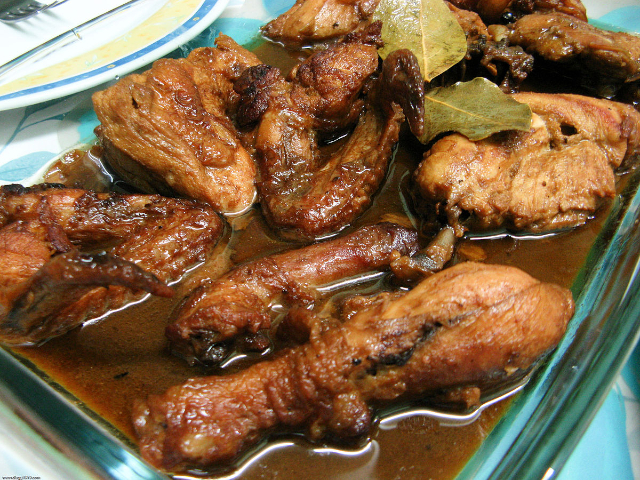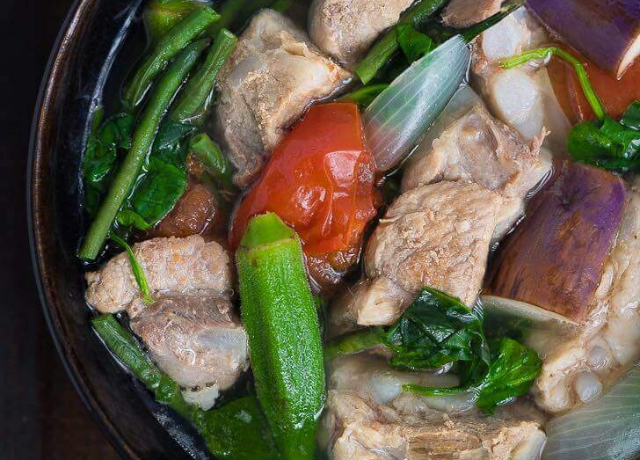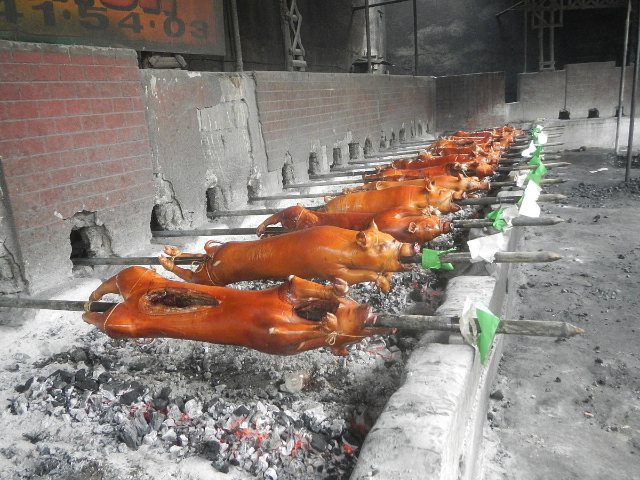This week, we’re taking a culinary trip to the Philippines – a nation composed of 7,640 islands that’s had a colourful and varied history, and has evolved a culture that incorporates influences from around the world – as well as preserving its own unique traditions…
 Filipino Adobo: A national dish…
Filipino Adobo: A national dish…
I guess we all know that the Philippines were a focus of fighting in the Pacific theatre during the Second World War. The Americans took them from the Japanese, were forced to give them back, and then re-took them on their march to the Japanese home islands.
I think Guy Fieri took one of his shows there, once. But I can’t be sure. Maybe I’m thinking of his trip to Hawaii… Anyway, up until recently, North Americans who have never visited in peacetime have probably not had a chance to taste what the Philippine national kitchen has to offer. However, the Filipino Jollibee restaurant chain penetrated the North American market a few years ago, and as a result, at least few ‘westerners’ have discovered the sometimes whacky, always delicious stuff that folks in the Philippines enjoy every day.
Filipino foods are generally considered to be among less-spicy (hot) than those of most other Southeast Asian countries. Filipinos are known the world around as master cooks who can throw together whatever ingredients they have on hand and come up with something scrumptious!
On our menu today
We’ll survey the country’s most beloved mains and sides. Some of these will remind you of dishes you’re already familiar with from Southeast Asian and Polynesian cuisine. But all are blessed with a unique Filipino touch.
Adobo: Not the Adobo you might be familiar with from Tex-Mex or Mexican cuisine, but a distinctly Asian take. Chicken, pork or lamb is marinated in vinegar, salt, garlic, pepper, soy sauce and other spices, then stewed. Adobo is at the top of just about every list of ‘must-try’ Filipino foods and, after trying it, you’ll know why!
Sinigang: A sour soup. Usually Pork (but occasionally beef, shrimp or fish) are used to set the theme of a pot of Sinigang. The sour comes from Tamarinds and Tomatoes…

Other flavours are contributed by spinach, onions and taro. And don’t forget the classic Sinigang Spice blend, available in most Asian groceries.
Sisig: Crispy Pig’s Face. You read right. In the Philippines, no part of an animal that can possibly be cooked goes to waste. Actually, Filipino cooks use chopped up meat from the pig’s head, plus pork belly, Chicken livers are also added in the traditional recipe, as are onions ginger, soy sauce, garlic, dried chilis and – we’re not pulling your leg, here – mayonnaise. The resulting ‘hash’ is usually served with steamed white rice. Filipinos have a word for foods like Sisig: ‘pulutan’ – ‘something that goes well with beer’!
Kare-kare: Enter, the Southeast Asian tradition of Peanut Sauce! The meat in this popular stew is Oxtail accompanied by a medley of fresh veggies; usually, string beans, eggplant, bok choy, and banana blossoms. The sauce is thickened with peanut butter and ground-up, toasted rice. Kare-kare is usually served with rice and a shrimp-based condiment called Bagoong. This is not a spicy (hot) peanut sauce concoction, so the timid can dig right in.
Lechon: Fire up the grill! This is the Filipino version of Luau: Whole Roasted Pig! Rather than burying the pig in the sand and steaming it over hot rocks, the Filipino roast pig is spit-roasted over a big bed of coals for hours.

It’s flavoured simply with a stuffing of lemongrass, onion, garlic and bay leaves. No big celebration on the Philippines is complete without Lechon! Roasting the pig is an all-day affair and is often treated as a social event around which the celebration is centred.
Crispy Pata: A whole leg of pork, deep fried until the skin is crispy and the inside is tender and juicy. The pork leg is first simmered with garlic, star anise, salt and pepper to ensure the meat come out tender. Then it’s rubbed with garlic, Pepper and salt. Serve it with white rice and a dipping sauce of soy and vinegar.
Kwek-kwek: The iconic street food of the Philippines (see photo, top of page). A hard-boiled quail egg covered in orange-flavourd batter. The experience is completed by choosing the right dipping sauce – and each street vendor has their own recipe. Thew traditional combo is vinegar with chilies and garlic.
A whole world of Filipino cuisine awaits!
The foregoing are just some of the most beloved and most famous Filipino mains. Go Googling and you’ll find that, where most countries have internet ‘must-try’ lists 10 or 15 dishes long, the Philippines’ lists generally run from 30 to 50 dishes! Tomorrow, we’ll survey the breads of the Philippines – a big part of daily life there!
~ Maggie J.

